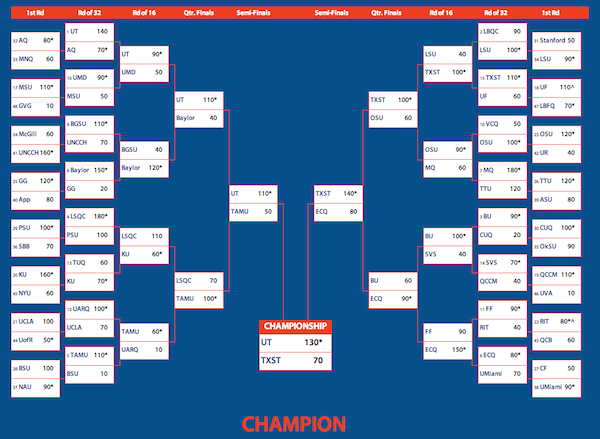It’s March Madness time again, which means everyone is wandering around looking at print-outs or electronic versions of a bracket. The bracket shows a tournament with 64 teams divided into four groups of 16 each. Within each group of 16, the teams are ranked or seeded from 1 to 16. In the first round of the tournament, represented on the outside of the bracket, 1 plays 16, 2 plays 15, 3 plays 14, and so on until you reach the 8 vs. 9 game. Many of these pairs of numbers are instantly recognizable to most sports fans. We all know that a 16 has never beaten a 1, that 12 seeds seem to upset 5 seeds more frequently than one would expect, and that once you get to an 8 vs. 9 or a 7 vs. 10 game, the teams are so evenly matched that you can’t call it an upset when the 9 or 10 seed wins. It occurred to me yesterday (this is a pretty obvious realization, but cut me some slack, I did have a fever) that if you add the two seed numbers, every matchup in the first round adds up to 17.
Cool! Now I know lots of ways to add to 17. I wasn’t sure how this was going to help me in life but I kept thinking. 17… 17 is one more than 16. 16 is the number of teams in each quarter of the tournament. So, the seed numbers add up to one more than the number of teams left in each quarter of the bracket. Does that work for later rounds too? Well, let’s assume there are no upsets in the first round. Seeds 1-8 advance, seeds 9-16 lose. 1 plays 8, 2 plays 7, 3 plays 6, and 4 plays 5 in the next round. All of those numbers add up to nine, which is one more than eight. Eight is the number of teams left in that side of the bracket! If you keep going with this logic, again with no upsets, it keeps working for a while. The next round would have 1 playing 4 and 2 playing 3. 1 beats 4, 2 beats 3, and then 1 and 2 play for the right to represent this quarter of the overall tournament in the… Final Four! That’s when the four groups of 16 teams merge and become a single tournament. This is where the logic breaks down, because you would expect all four 1 seeds to make it, so that round’s sum would be two even though there are four teams left and the same would be true for the final game when there are only two teams left.
I might have lost you there for a minute (or maybe forever) but I’m about to bring it back to reality a little. We know that the favorites don’t always win during March Madness. Yesterday it seemed like the favorites were barely going to win at all! Already we’ve had 14 seeds beat 3 seeds, 11 beating 6, and 9 beating 8. This means that things won’t work so nicely in the second round. For example, instead of 3 seed Iowa State playing 6 seed SMU (adds up to 9) in the next round, we’re going to have 14 seed UAB playing 11 seed UCLA. 14 plus 11 is 25 not 9. The sum trick only works if the favorites always win.
Once I realized this, I was disappointed for a few minutes. Being disappointed because upsets ruin my little math trick is silly, of course. Upsets are what make March Madness so great. They’re what puts the Madness in March Madness. Then I had a (minuscule) Eureka moment. We can quantify exactly how “mad” each quarter of the bracket is by adding up the seed numbers of the teams that advance and subtracting the number we would have gotten if all the favorites had won. Call it the Madness Metric™. Using that same example of UAB and UCLA advancing instead of Iowa State and SMU, you would take their seeds, 14 and 11, add them to get 25 and then subtract 9 (the expected seed sum for the next round of the tournament) to get 14. 14 is pretty mad!
It’s not an advanced metric by any means, but it is a fun way to compare the regions (each quarter of the tournament is called a region because it’s played in one spot, not because the teams are from one place) to see which one is the maddest of them all! I’ll report back at the end of each round on this metric.

